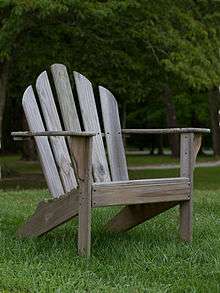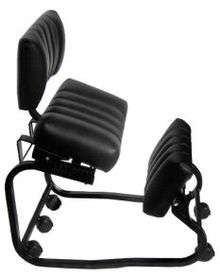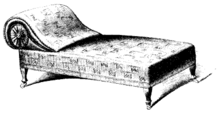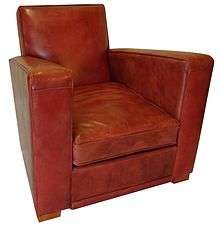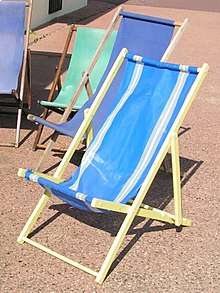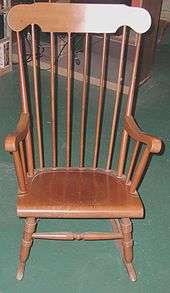List of chairs
The following is a partial list of chair types, with internal or external cross-references about most of the chairs.
0-9
- 10 Downing Street Guard Chairs, two antique chairs used by guards in the early 19th century
- 40/4 (forty-in-four) stacking Chair designed by David Rowland, 1964
A
- Aalto armchair 406, designed by Alvar Aalto in 1938; IKEA sells a similar design as the Poäng lounge chair
- Adirondack chair, a non-adjustable wooden outdoor lounge chair
- Aeron chair, an ergonomic trademarked chair
- Air chair,[1] a lightweight moulded chair design by Jasper Morrison
- Armchair, has armrests for comfort; couches, sofas,etc.
B
- Bachelor's chair, dates from the 18th century and converts into a stepstool, ladder or ironing board[2]
- Balans chair, designed by Norwegian furniture designer Peter Opsvik in 1979, is the original kneeling chair design
- Ball Chair, designed by Finnish furniture designer Eero Aarnio in 1963Ball chair
- Bar stool, tall, narrow stool designed for seating at a bar or counter
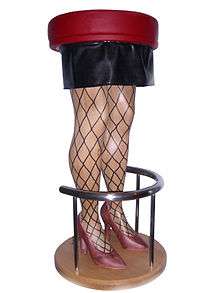 Bar stool chair
Bar stool chair - Barcelona chair, proprietary chair designed in 1929 by the German architect Ludwig Mies van der Rohe and widely copied since; characterized by leather upholstery, an angled seat and back without armrests, and X-shaped steel legs
- Bardic chair, custom chair built every year for the winner of an Awdl poetry contest in Wales
- Barrel chair,[3] has a high round back like half a barrel; large and upholstered
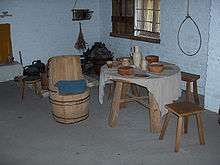 Barrel chair, c. 1465, Raversijde, Belgium
Barrel chair, c. 1465, Raversijde, Belgium - Bath chair, light carriage on wheels with a folding hood, for outdoor transport, often used by invalids
- Beach chair (Strandkorb), designed to provide comfort and protection from sun, wind, rain, and sand on beaches frequented by tourists
- Bean bag chair. The first bean bag chair is Sacco, designed in 1968 by the Italian designers Piero Gatti, Cesare Paolini, Franco Teodoro.
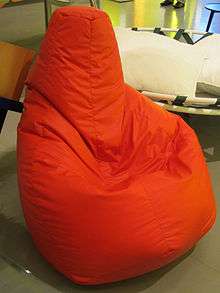 Sacco [1968]: Piero Gatti, Cesare Paolini, Franco Teodoro.
Sacco [1968]: Piero Gatti, Cesare Paolini, Franco Teodoro. - Bench, a simple, often backless device, typically for more than one person to sit on; often refers to a simple, longer table or similar longer flat surfaces to place things on or work on
- Bergère, upholstered chair introduced in the Régence/Rococo period in France in the 17th century
- Bikini chair, designed by architect Wendell Lovett in 1949 and first exhibited in 10th Triennale di Milano 1954; made of metal, molded plastic, and leather; featured in the magazine Domus February 1954 (#291)
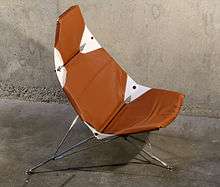 Bikini chair, 1949
Bikini chair, 1949 - Bofinger chair, first chair worldwide in fiberglass-reinforced polyester to be produced in one single process over a steel mould; considered a classic of modern furniture design history
- Bosun's chair, a device used to suspend a person from a rope to perform work aloft
- Breuer Chair, designed by Marcel Breuer; distinguished by a cantilevered design, steel tubular frame and caning[4]
- Brewster Chair, a style of upright, turned, wooden armchair made in the mid-17th century in New England named after Pilgrim and colonial leader William Brewster of Plymouth, Massachusetts
- Bubble Chair, designed by Eero Aarnio in 1968 in Finland; a modernist classic
- Bungee chair, any chair which incorporates bungee cords as a primary material
- Butterfly chair[5] (BKF chair) designed in 1938 by Bonet, Kurchan and Ferrari-Hardoy (Argentina); a light folding metal frame with a large cloth or leather sling hung from the frame's four high points
C
- Campeche chair, a 19th-century Mexican lounge chair, popular in Latin America, the Caribbean, and the American South. It has X-shaped sides and a sling seat and back made of leather, cane or wood slats. Similar to a planter's chair, but without the extended arms.
- Cantilever chair, has no back legs; for support its seat and back cantilever off the top of the front legs
- Captain's chair, was originally a low-backed wooden armchair;[6] today the term is often applied to adjustable individual seats in a car with arm rests
- Caquetoire, also known as a conversation chair, used in the European Renaissance, was developed for women because it was wider so women's fashions at the time could fit into it; this is demonstrated by the "U" shaped arms
- Car chair, a car seat in an automobile in which either the pilot or passenger sits, customarily in the forward direction. Many car chairs are adorned in leather or synthetic material designed for comfort or relief from the noted stress of being seated. Variants include a toddler's or infant's carseat, which are often placed atop an existing chair and secured by way of extant seat belts or other such securant articles.
- Carver chair, similar to a Brewster chair and from the same region and period
- Cathedra, a bishop's ceremonial chair
- Chaise a bureau, a Rococo style of chair, created during the first half of the 18th century, constructed so it could sit in a corner of a room (there is one leg directly in the back and one directly in the front, and then one leg on each side)
- Chaise longue (French for "long chair"), a chair with a seat long enough to completely support its user's legs. In the U.S., it is often mistakenly referred to as a 'chaise lounge'. Similar, if not identical to, a day bed, fainting couch, or récamier.
- Chesterfield chair, a low club-style chair with a fully buttoned or tufted interior, typically made of leather
- Chiavari chair, designed in 1870 by Giuseppe Gaetano Descalzi of Chiavari in Italy. The chair is lightweight, has elegant lines, yet is strong, practical and easy to handle.
- Club chair, a plush easy chair with a low back. The heavy sides form armrests that are usually as high as the back. The modern club chair is based upon the club chairs used by the popular and fashionable urban gentlemen's clubs of 1850s England.
- Cogswell chair,[7] a brand of upholstered easy chairs. It has a sloping back and curved and ornamental front legs. The armrests are open underneath.
- Corner chair, made to fit into a corner and has a rectangular base with a high back on two adjacent sides; one sits with legs straddling a corner of the base (some sources claim this design was to accommodate a man wearing a sword)
- Curule chair was a folding cross-framed seat that developed hieratic significance in Republican Rome. The shape of its legs was revived in the Empire style.
D
- Dante chair, similar to the Savonarola chair with a more solid frame and a cushioned seat
- Deckchair,[8] a chair with a fabric or vinyl back and seat that folds flat by a scissors action round a transverse axis. The fabric extends from the sitter's feet to head. It may have an extended seat that is meant to be used as a leg rest and may have armrests. It was originally designed for passenger lounging while aboard ocean liners or ships.
- Dentist chair, a deeply reclining chair to allow the dentist easy access to the patient's mouth. The reclining position adjusts as well as the overall height of the chair. Associated with the chair are usually a variety of dental equipment, often including a small tap and sink for the patient to rinse his or her mouth.
- Dining chair, designed to be used at a dining table; typically, dining chairs are part of a dining set, where the chairs and table feature similar or complementary designs. The oldest known depiction of dining chairs is a seventh-century BCE bas-relief of an Assyrian king and queen on very high chairs.[9]
- Director's chair,[10] a lightweight chair that folds side-to-side with a scissors action. The seat and back are made of canvas or a similar strong fabric which bears the user's full weight and can be folded; the frame is made of wood, or sometimes metal or plastic. The seat and scissors members work together to support and distribute the sitter's weight so that the seat is comfortably taut. The back is usually low and the chair usually has armrests. The stereotypical image of a movie director on location includes one of these chairs, hence the name. Victor Papanek describes this chair as an excellent design in his book Design for the Real World as it is simple and ideally suited to its function. The design goes back to coffer-makers' chairs of the 15th century and eventually to the Roman curule chair.
E
- Easy chair,[11] large, soft, and very comfortable; usually upholstered
- Eames Lounge Chair, a trademark for molded plywood chairs, contoured to fit the shape of a person
- Egg chair, designed by Arne Jacobsen and resembles an egg or womb
- Electric chair, a device for capital punishment by electrocution; a high-backed chair with arms and restraints, usually made of oak
- Elijah's chair, a chair set aside for the prophet Elijah at Jewish circumcision ceremoniesAn example of an Elijah's chair, used at Jewish circumcisions
- Emeco 1006, a durable aluminum chair original developed for the US Navy
F
- Farthingale chair, an armless chair with a wide seat covered in usually high-quality fabric and fitted with a cushion. The backrest is an upholstered panel, with legs that are straight and rectangular. It was introduced as a chair for ladies in the late 16th century and was named in England, probably in the 19th century, for its ability to accommodate the exceptionally wide-hooped skirts fashionable of the time.
- Fauteuil, an open-arm chair with considerable exposed wood, originating in 18th-century France
- Fiddleback chair, a wooden chair of the Empire period, usually with an upholstered seat, in which the splat resembles a fiddle
- Fighting chair[12] is a chair on a boat used by anglers to catch large saltwater fish. The chair typically swivels and has a harness to keep the angler strapped in should the fish tug hard on the line.
- Folding chair, collapses in some way for easy storage and transport. Various folding chairs have their own names (e.g., deckchair, director's chair), but a chair described simply as a folding chair folds a rigid frame and seat around a transverse axis so that the seat becomes parallel to the back and the frame collapses with a scissors action. Some further collapse the feet up to the back. Folding chairs may be designed to stack on top of each other when folded and may come with special trolleys to move stacks of folded chairs. Folding chairs are sometimes used in professional wrestling as weapons.
- Folding seat, a fixed seat on a bus, a tram or a passenger car
- Friendship bench, a special place in a school playground where a child can go when he or she wants someone to talk to
G
- Gaming chair, legless, curved/L-shaped, generally upholstered, and sometimes contains built-in electronic devices like loudspeakers and vibration to enhance the video game experience; the five main types of gaming chairs are bean bags, rockers, pedestals, racers, and cockpits
- Garden Egg chair, designed by Peter Ghyczy and a modernist classic
- Glastonbury chair, a wooden chair with flat seat and sloping back
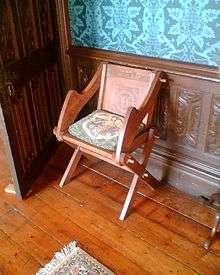 A reproduction Glastonbury chair in the Bishop's Palace, Wells
A reproduction Glastonbury chair in the Bishop's Palace, Wells - Glider (or platform rocker), offers the same motions as a rocking chair but without the dangers; a frame rests on the floor and the chair is supported by swing arms within the frame so that moving parts are less accessible
H
- Hassock, an upholstered seat that is low to the ground and has no backrest
- High chair, a children's chair to raise them to the height of adults for feeding. They typically come with a detachable tray so that the child can sit apart from the main table. Booster chairs raise the height of children on regular chairs so they can eat at the main dining table. Some high chairs are clamped directly to the table and thus are more portable.
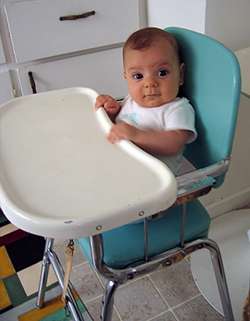 High chair by Cosco, 1957
High chair by Cosco, 1957 - Hanging Egg Chair, designed by Danish furniture designer Nanna Ditzel in 1957
I
- Inflatable chair, usually children's toys made out of plastic; IKEA briefly marketed them as serious furniture upholstered in fabric; some are designed for use as floating lounge chairs in swimming pools.
- Ironing chair, a lightly built folding chair usually with a metal frame and small padded seat and either a minimal padded back or a simple tubular loop back. The chair is usually used as a 'perch', a support for carrying out an activity - such as ironing - by people with disabilities or back problems, but they are also popular with anyone requiring a light supporting chair for extended periods, such as observing through a telescope.[13]
J
- Jack and Jill, similar to the Adirondack chair, but consists of two of them joined in the middle by a table
- Jump seat, in an airplane
K
- Kneeling chairs or knee-sit chairs,[14] meant to support someone kneeling. This is purportedly better for the back than sitting all day. The main seat is sloped forward at about 30 degrees so that the person would normally slide off, but there is a knee rest to keep the person in place.
- Knotted chair, designed by Marcel Wanders in 1995 and distributed in the Droog design collection
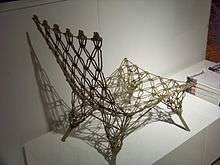 Knotted chair, 1995
Knotted chair, 1995
L
- Ladderback chair, a wooden arm or side chair in which the horizontal elements of the back give the appearance of a ladder; typically described by the number of such elements; a 'five-back', a 'three-back'; on better examples, the width of these elements is graduated, wider to narrower, top to bottom
- Lambing chair, a wood "box" form of winged arm chair rarely having upholstery. Storage under the seat is common as a drawer or compartment.
- Lawn chair, usually a light, folding chair for outdoor use on soft surfaces. The left and right legs are joined along the ground into a single foot to make a broader contact area with the ground. Individual feet would otherwise dig into soft grass.
- Lifeguard chairs, enable a lifeguard to sit on a high perch at the beach to better look for swimmers in distress
- Lift chair, a powered lifting mechanism that pushes the entire chair up from its base, allowing the user to easily move to a standing position
- Litter, also known as "sedan chair", a covered chair carried by people and used to transport others
- Louis Ghost chair, a transparent polycarbonate design by Philippe Starck
M
- Massage chair, has electromechanical devices to massage the occupant. Another kind of massage chair is one used by a therapist on which the client sits in an inverted position with the back facing the massage therapist. There is a headrest like that of the common massage table for the face.
- Monobloc chair, a cheap, light-weight, stackable, weatherproof, easily cleaned, single-piece polypropylene chair designed for mass production via injection molding
- Morris chair,[15] a proprietary easy chair with adjustable back, cushions, and armrests
- Muskoka chair, another name for an Adirondack chair, particularly in Canada[16]
N
- Navy chair, a durable all-aluminum chair originally developed for the US Navy
- No. 14 chair, the most famous bentwood sidechair originally made by the Thonet chair company of Germany in the 19th century, and widely copied and popular today
- Nursing chair, a low-seated partially upholstered chair used in Victorian times, with emphasis on a woman breast-feeding an infant
O
- Office chair, typically swivels, tilts, and rolls about on casters, or small wheels. It may be very plushly upholstered and in leather and thus characterized as an "executive chair", or come with a low back and be called a steno chair. Office chairs often have a number of ergonomic adjustments: seat height, armrest height and width, and back reclining tension.
- Orbiter, a brand of camera seat used by camera operators that swivels at a low working height.
- ON Chair, has a patented three-dimensional sitting arrangement; incorporates lateral movement to standard office chair height and reclining positions
- Ottoman, a thick cushion used as a seat or a low stool, or as a rest for the feet of a seated person
- Ovalia Egg Chair, similar to the Ball Chair but egg-shaped; designed by Henrik Thor-Larsen in 1968[17]
- Onit chair, a chair which is also a set of steps and an ironing board.
P
- Panton Chair, a one-piece plastic chair by Danish designer Verner Panton
- Papasan chair, a large, rounded, bowl-shaped chair with an adjustable angle similar to that of a futon; the bowl rests in an upright frame made of sturdy wicker or wood originally from the Philippines
- Parsons chair, curving wooden chair named for the Parsons School of Design in New York, where it was created and widely copied today
- Patio chair, any outdoor chair meant for use on a hard surface (contrast with lawn chairs) designed so as to not collect water and dry quickly after rain
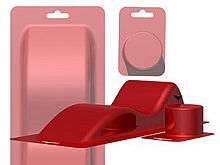 "Pop" (2005), a whimsical variation of a patio chair by the American industrial designer Brad Ascalon
"Pop" (2005), a whimsical variation of a patio chair by the American industrial designer Brad Ascalon - Peacock chair, a large wicker chair with a flared back, originating in the Philippines; also an exaggerated Windsor chair design by Hans Wegner (1947).
- Pew, a bench in a church
- Pew stacker chair, stackable chair used primarily by churches that allows chairs arranged in rows to be linked together in such a way that the seats and backs form a bench- or pew-like feel and appearance
- Planter's chair, wooden chair with stretchable arms to rest the legs
- Poäng, a flat-pack cantilevered bentwood armchair manufactured and marketed by Ikea, with more than 30 million made since its introduction in 1978, and 1.5 million sold annually.
- Poofbag chair, similar to an oversized bean-bag chair filled with urethane foam
- Porter's chair, a chair placed near the entrance of a large house for use by a servant responsible for admitting visitors
- Potty chair[18] (often abbreviated simply as "potty"), a training toilet for children; in pre-indoor plumbing times this was a chair beneath the seat of which a chamber pot was installed
- Portuguese chair, metal outdoor armchair originally developed by the Portuguese furniture company Adico in the 1930s as the 5008 chair, becoming a symbol of the Portuguese cafe culture. The Gonçalo chair, designed by Gonçalo Rodrigues dos Santos in the 1940s, is one of the most famous derivatives of the 5008 chair.[19]
- Pouffe, furniture used as a footstool or low seat
- Power chairs, with responsive joystick controls and a tight turning circle for elderly or disabled people to move around a house[20]
- Pressback chair, a wooden chair of the Victorian period, usually of oak, into the crest rail and/or splat of which a pattern is pressed with a steam press
- Pushchair or stroller,[21] a chair with wheels, which usually folds for transporting an infant; some countries, including the U.S., use "stroller"; others, including the UK, "pushchair"
Q
R
- Recliner,[22] a chair with a reclining back; most are armchairs and may come with a footrest that unfolds when the back is reclined
- Red and Blue Chair a chair designed by Dutch architect and furniture designer Gerrit Rietveld.
- Restraint chair, a type of physical restraint used to prevent injury to themselves or others
- Revolving chair, an older term for swivel chair
- Rex chair, a foldable chair designed by Slovene designer Niko Kralj in 1952
- Ribbon Chair[23], designed by Niels Bendtsen in 1975. This chair is on display in a permanent collection at The Museum of Modern Art in New York.
- Rocking chair (rocker), typically a wooden sidechair or armchair with legs mounted on curved rockers, so that the chair can sway back and forth; sometimes the rocking chair is on springs or on a platform (a "platform rocker") to avoid crushing anything, particularly children's feet or pets' tails, that get under the rockers
- Rover chair, designed by Ron Arad
- Rumble seat
S
- Saddle chair, uses the same principles in its design as an equestrian saddle; does not have a backrest but is equipped with a chair base on casters and a gas cylinder for adjusting the correct sitting height; the casters enable moving around and reaching out for i.e. tools while sitting
- Savonarola chair, a folding armchair dating from the Italian Renaissance. Typically constructed of walnut, it is sometimes called an X-chair. The Savonarola chair was the first important folding armchair created during the Italian Gothic Renaissance period.
- Sedan chair, an open or enclosed chair attached to twin poles for carrying; using this form of transport, an occupant can be carried by two or more porters
- Sgabello, from the Italian Renaissance and made of walnut, consisting of a thin seat back and an octagonal seat; sometimes considered a stool and was often placed in hallways
- Shaker rocker, one of several forms of rocking chair, including side chairs, made by Shakers
- Shaker tilting chair, allowed a person to lean back with the chair without slipping or scraping the floor
- Shower chair, a chair which is not damaged by water, sometimes on wheels, and used as a disability aid in a shower, similar to a wheelchair but has no foot pads; is waterproof and dries quicklyA shower chair
- Side chair, a chair with a seat and back but without armrests; often matched with a dining table or used as an occasional chair
- Sit-stand chair,[14] normally used with a height-adjustable desk, allows the person to lean against this device and be partially supported
- Sling chair, a suspended, free-swinging chair hanging from a ceiling
- Slumber chair, an easy chair manufactured by C. F. Streit Mfg. Co. in the first half of the 20th century; has a combination upholstered back and seat portion, the inclination of which is adjustable within a base frame; later versions of this chair had a footstool with a removable top that could reveal a "slipper-compartment"
- Spinning chair, commonly used with computers due to its ability to move freely
- Stacking chair, designed to stack compactly on top of each other to minimize storage space required
- Steno chair, a simple office chair, usually without arms, meant for use by secretarial (or a stenographer) staff
- Step chair, a chair which doubles as a small set of steps when folded out.
- Stool, a chair without back and armrests
- Sweetheart chair, as used in soda shops, also known as a "parlor chair" and an "ice cream chair" (from use in ice cream parlors); the wire frame in the center of the back curls in a manner to suggest a heart design but the term "sweetheart chair" also has a more generic usage and refers to any chair with a heart-shaped design in the center of the back
- Swivel chairs, swivel about a vertical axis; commonly used in offices, often on casters
T
- Tantra Chair, for practicing the Kama Sutra[24]
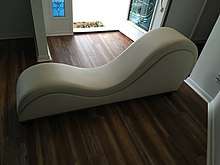 The Tantra Chair or Kama Sutra Chair designed by AJ Vitaro
The Tantra Chair or Kama Sutra Chair designed by AJ Vitaro - Tarachair, high-legged wooden chair designed to encourage raised conversation between people, popular first in San Francisco and now Los Angeles
- Tête-à-tête chair, also known as a courting bench, a type of settee consisting of two connected chairs which allow two people to sit facing one another
- Throne, a ceremonial chair for a monarch or similar dignitary of high rank
- Toilet chair, a disability aid attached to a normal toilet
- Tuffet, a low seat often used as a footrest, similar to an ottoman but shorter and with no legs
- Tulip chair, designed by Eero Saarinen in 1956 and considered a classic of industrial design
- Turned chair (or thrown chair or spindle chair), made of turned wood spindles by turners (with the use of a lathe), rather than by joiners or carpenters
- two-slat post-and-rung shaving chair, made from green wood, rived and shaved with a drawknife rather than turned, made by Jennie Alexander[25]
V
W
- Wainscot Chair, an unupholstered oak chair popular in 17th-century colonial America
- Watchman's chair, an unupholstered wooden chair with a forward slanted seat to prevent a watchman from falling asleep
- Wassily Chair, a tubular-steel chair designed by Marcel Breuer
- Wheelchair, a chair on wheels for someone who cannot walk or has difficulty walking
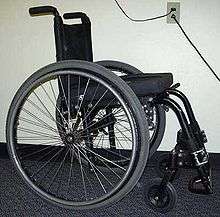 A lightweight wheelchair
A lightweight wheelchair - Wicker chair, made of wicker and is thus ventilated and useful under hot or humid conditions; likewise, a cane chair
- Wiggle chair, cardboard seating form designed by Frank Gehry in 1972
- Windsor chair,[28] a classic, informal chair usually constructed of wood turnings that form a high-spoked back, often topped by a shaped crest rail, outward-sloped legs, and stretchers that reinforce the legs. The seat is often saddled or sculpted for extra comfort, and some Windsors have shaped arms supported by short spindles.
- Wing chair,[29] an upholstered easy chair with large "wings" mounted to the armrests and enclosing the head or torso areas of the body; originally designed to provide comfortable protection from drafts; a variation is the Queen Anne wing chair
- Writing armchair, the most compact rendition of a school desk
X
- X-chair, a chair with an X-shaped frame
Y
Z
- Zaisu, a Japanese legless chair
- Zig-Zag Chair, designed by Gerrit Rietveld
- Zero-gravity chairs, belong to Peter Opsvik's balans family. Designed to reduce "downward pressure" on joints "giving a sense of weightlessness".[30]
gollark: æææææææææææĸĸĸĸĸĸĸnslknamslkansklanskldasndklans æßðæßþðł ø¹€¹ łł¶łeŧ €¹²\¹¸¹¸¹\¹¹\¹\\¸\²²\³ĸ³²³½
gollark: No.
gollark: controller bad; keyboard good
gollark: Oh dear. Did someone do ban?
gollark: i told you, I deleted all babies™
References
- "Air-Chair". Jasper Morrison. 2013-08-08. Retrieved 2013-10-29.
- Rohrlich, Marianne (1998-06-04). "Currents; CONTRAPTION - Step Right This Way (Or That Way)". New York Times. Retrieved 2011-09-23.
- Barrel chair. The American Heritage Dictionary of the English Language: Fourth Edition. 2000 Archived 2004-10-10 at the Wayback Machine
- "Breuer Chair". Seats and Stools. Retrieved 13 February 2014.
- "Bartleby.com: Great Books Online -- Quotes, Poems, Novels, Classics and hundreds more". bartleby.com. Archived from the original on 2008-10-14. Retrieved 2014-04-12.
- captain's chair. The American Heritage Dictionary of the English Language: Fourth Edition. 2000 Archived 2004-10-09 at the Wayback Machine
- Cogswell chair. The American Heritage Dictionary of the English Language: Fourth Edition. 2000 Archived 2004-10-09 at the Wayback Machine
- "Bartleby.com: Great Books Online – Quotes, Poems, Novels, Classics and hundreds more". bartleby.com. Archived from the original on 2008-07-06. Retrieved 2014-04-12.
- Rybczynski, Witold (23 August 2016). "Sitting up". The Paris Review. Retrieved 26 August 2016.
- "Bartleby.com: Great Books Online – Quotes, Poems, Novels, Classics and hundreds more". bartleby.com. Archived from the original on 2008-07-25. Retrieved 2014-04-12.
- Easy chair. The American Heritage Dictionary of the English Language: Fourth Edition. 2000
- fighting chair. The American Heritage Dictionary of the English Language: Fourth Edition. 2000 Archived 2004-12-05 at the Wayback Machine
- "Alternative Chairs". Ccohs.ca. 2007-04-16. Retrieved 2011-09-23.
- Morris chair. The American Heritage Dictionary of the English Language: Fourth Edition. 2000 Archived 2004-10-10 at the Wayback Machine
- Garnett, Glenn. "Adirondack/Muskoka Chairs". Cottage Link Magazine. Retrieved 2011-09-23.
- "Ovalia Egg Chair". Ovalia.com. 1990-01-01. Retrieved 2014-04-08.
- potty-chair. The American Heritage Dictionary of the English Language: Fourth Edition. 2000 Archived 2004-10-09 at the Wayback Machine
- 5008 Portuguese chair
- "Power Chairs". MSL Mobility Centre.
- "Pushchair". Cambridge Dictionaries Online. Retrieved 2011-09-23.
- "Recliner". Merriam-Webster Online Dictionary. Retrieved 2011-09-23.
- "Image: Niels Sylvester Bendtsen. Ribbon Chair. 1975 | MoMA". images.google.com. Retrieved 2018-12-20.
- James, Anna. "The Tantra Chair". e|Mercedes Benz. Retrieved 16 April 2020.
- Alexander, Jennie (1978). Make a chair from a tree : an introduction to working green wood. Newtown, Conn.: Taunton Press. ISBN 0918804019. OCLC 4715888.
- "Reception Chair". Brothers Office Furniture.
- "Online catalogue of antique auction houses in the UK". UK Auctioneers. Archived from the original on May 4, 2012. Retrieved 2011-09-23.
- "Bartleby.com: Great Books Online -- Quotes, Poems, Novels, Classics and hundreds more". bartleby.com. Archived from the original on 2008-10-11. Retrieved 2014-04-12.
- "Wing chair". Cambridge Dictionaries Online. Retrieved 2011-09-24.
- "Varier Gravity balans". Retrieved 2017-09-16.
| Wikimedia Commons has media related to Chairs. |
This article is issued from Wikipedia. The text is licensed under Creative Commons - Attribution - Sharealike. Additional terms may apply for the media files.
